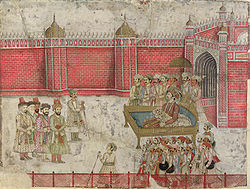- Nadir Shah's invasion of India
-
Invasion of India Part of Campaigns of Nadir Shah 
The Nawab of Awadh and the Persians negotiate.Date 1738-39 Location Delhi, India Result Persian victory Belligerents  Afsharid dynasty
Afsharid dynasty
 Kingdom of Georgia
Kingdom of Georgia Mughal Empire
Mughal EmpireCommanders and leaders  Nadir Shah
Nadir Shah
 Heraclius II
Heraclius IIMuhammad Shah Strength 55,000 100,000 Casualties and losses 2,500 20,000 Persia–-Ottoman Empire–-India–-Bokhara, Khiva, Khwarezm, Kazakhs, Dagestan, Lezgin–-MazanderanNadir Shah's Invasion of India was important foreign invasion of India in 1738-39. Emperor Nader Shah, the Shah of Iran (1736–47) and founder of the Afsharid dynasty, invaded India with a half of a hundred men, eventually attacking Delhi in February 1739, looting and plundering the city, after issuing orders of a general massacre. [1] His army defeated the Mughal emperor Muhammad Shah in battle at Karnal and took control of northern India.[2] His bloodshed gave way to the word nadirshahi, synonymous with Holocaust.
Invasion
Nadir Shah was the leader of a warband. In 1736, his troops captured Esfahan from the Safavid dynasty and founded the Afsharid dynasty. Nadir began to launch forays across the Hindu Kush mountains into India, home to the Mughals, starting in 1738. The shah defeated his Afghan enemies fleeing into the Kush, also seizing the major cities of modern-day Pakistan before advancing to the Punjab and capturing Lahore. But his guise soon fell when the Mughals advanced on his army, which was really planning to conquer India. At the Battle of Karnal in 1739, Nadir and his Georgian allies smashed the Indian army. Muhammad surrendered, and the two went into Delhi together. Some Indians rebelled shortly after, but up to 30,000 civilians were massacred and Muhammad begged for mercy. Nadir took the Peacock Throne, Kohinoor diamond (now part of the British Crown Jewels) and several other valuable belongings (including elephants and weapons) and left back for his homeland. [2]
References
- ^ Marshman, P. 200
- ^ a b "Nadir Shah". Britannica.com. http://www.britannica.com/EBchecked/topic/401451/Nadir-Shah.
- "Muhammad Shah". The Cambridge History of India. CUP Archive. 358-364. http://books.google.co.in/books?id=yoI8AAAAIAAJ&pg=PA360&dq=nadir+shah+India&hl=en&ei=AIzLTqKcKITnrAeapInnDA&sa=X&oi=book_result&ct=result&resnum=1&ved=0CC4Q6AEwAA#v=onepage&q=nadir%20shah%20India&f=false.
- John Clark Marshman (1863). "Nadir Shah". The History of India. Serampore Press. p. 199. http://books.google.co.in/books?id=OHcIAAAAQAAJ&pg=PA199&dq=nadir+shah+India&hl=en&ei=AIzLTqKcKITnrAeapInnDA&sa=X&oi=book_result&ct=result&resnum=4&ved=0CDoQ6AEwAw#v=onepage&q=nadir%20shah%20India&f=false.
- Grant, RG: Battle
- (Nadir Shah) Until His Assassination In A.D. 1747. A Literary History of Persia by Edward G. Browne. Publisher T. Fisher Unwin, 1924.
Categories:- Conflicts in 1738
- Conflicts in 1739
- History of Delhi
- Mughal Empire
- 1739 in India
- Wars involving Georgia (country)
Wikimedia Foundation. 2010.
